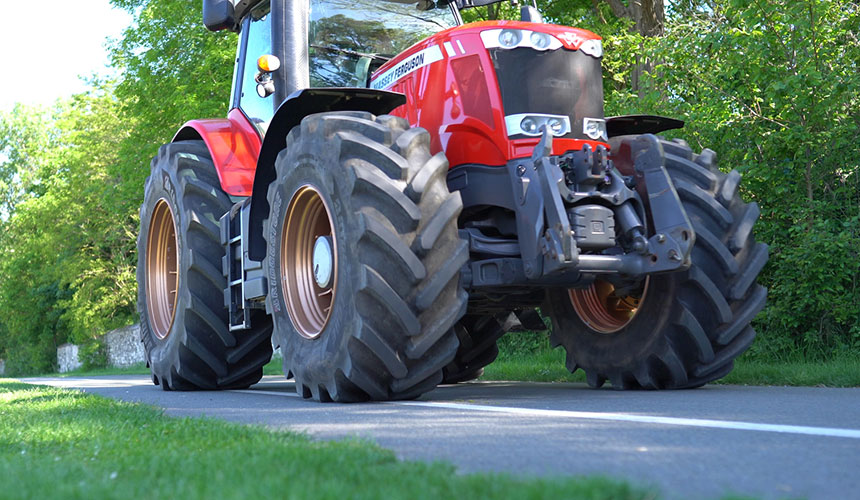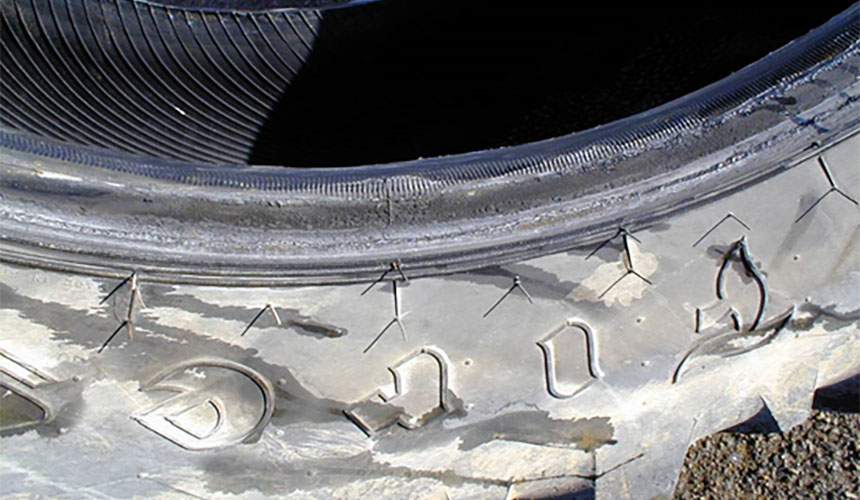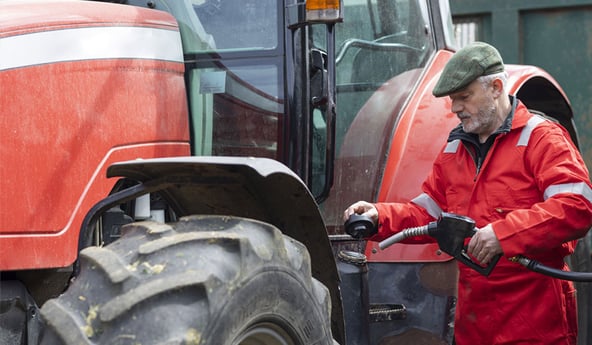There are many possible reasons that cause your agricultural machinery to vibrate, one of them being your tyres.
These natural vibrations linked to the form of the lugs can either be very slight and without consequence if all the settings are correct, or really problematic if they lead to an increase of the tractor vibrations which is felt strongly in the cab.
Furthermore, abnormal vibration of the tyres will accelerate wear and reduce their lifespan substantially.
In this article we look at the different causes of vibration among the most frequent linked to tyres and different solutions to resolve these problems.
Agricultural tyres have a much more furrowed design than other categories of tyre. On the tread, the lugs are large and voluminous to be able to transmit the tractive effort on soft ground.
This specific construction, with a certain number of lugs, leads naturally to recurrent vibration when driving, when each lug comes into contact with the ground.
Research and development work on the design of agricultural tyres is therefore very important, because the quality of this work determines whether you have good traction capacity in the fields and good road handling with a minimum amount of vibrations.
1. Alignment of the tyre vibration with the drive chain
The vibration of the engine and the entire drive chain (transmission parts which make the wheels move), must never have the same rhythm of vibration as the natural vibration generated by the tyres.
If the rhythm of vibration is identical, there is an amplification which can generate resonance and accelerate the frequency of oscillations. The vibration then becomes greater than the vibration of the engine alone and can lead to mechanical problems or discomfort for the user.
To confirm that the problem effectively comes from the tyres, you can compare the level of vibration felt at the rear with the engine running and the level of vibration felt when driving.
To solve this problem, the simplest solution is to modify the air pressure in the tyres.
A change in pressure (increase or decrease) will effectively change the form of the tyre and modify very slightly the tyre’s road contact vibration frequency.
This minor adjustment is sometimes enough to desynchronise the vibration of the tyres and of the engine.
If the problem persists:
you can change tyre size when the time comes to replace your tyres, which will modify the vibration frequency because the tyres will have different dimensions.
2. Vibration linked to a tyre mounting fault
You need to be highly focused when mounting or dismounting tyres to ensure that the tyre fits perfectly into position on the rim.
Whether it’s done manually or with the help of a machine, lubricating the beads is essential.
If the bead is not properly lubricated during mechanical mounting, it may be positioned at an angle on the edge of the rim, leading to a form of vibration when driving with either a loss of air or instability when driving with a right/left sway.
To resolve this problem you must remove the beads from the rim and remount the tyre, making sure the beads are well lubricated.
However, when dismounting the tyre you should check that the bead has not been damaged or cut or become irreversibly misshaped, which would mean the tyre has to be replaced to be able to drive in complete safety once more.
3. Vibration linked to an oval rim or tyre
A rim with a welded disc may have a very slightly oval form, which will produce a vibration effect when driving.
If the deformation is beyond acceptable reference standards, this is certainly linked to a manufacturing defect.
With the right measurement tools, your tyre dealer can help you check the form, by determining the high point and low point of the rim.
Unfortunately, if the measurements are not within the norm, the only option will be to replace the tyre.
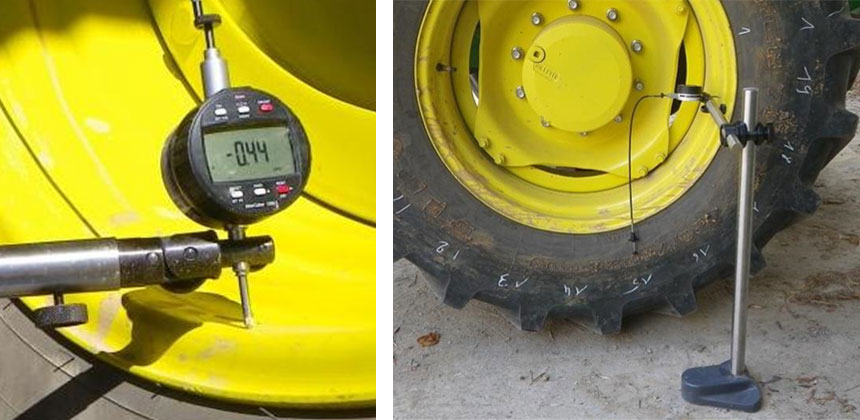 Checking rim concentricity
Checking rim concentricity
If the rim is made up of several parts, or the disc is bolted to the crown, you can check that the connections between rim and disc are properly centred in relation to each other.
For example, for old generation tractors equipped with rims with brackets, you may have difficulty keeping the discs in the centre on the rims due to a progressive degree of play in the bolts.
If you identify any irregularity, don’t hesitate to loosen the bolts and realign everything. If the vibration continues, you should check whether the rim is misshapen, and if your measurements are outside the acceptable standards, you will have to replace the tyre.
The cause of the vibrations may also be linked to the tyre, which may have a faulty design with a slightly ovoid form.
To check this you can take measurements to verify the dimension of the radius compared to the wheel axis centreline.
In certain cases it is possible for the wheel and the rim to have an ovoid shape.
By using the different rim and tyre measurements, you can balance things out by rotating the tyre on the rim so that one defect is compensated by the other, thus obtaining a full realignment.
4. Vibration linked to a geometry problem
Vibrations are most frequently linked to geometry problems. In this case the vibrations increase with acceleration.
It may be a problem with parallelism or camber:
- Parallelism, this is the setting to align the wheels with the tractor’s centreline, to have four wheels that are perfectly parallel to the tractor’s direction of travel.
- Camber, this is the vertical setting of each wheel, which should always be perfectly perpendicular to the flat surface of the road or ground.
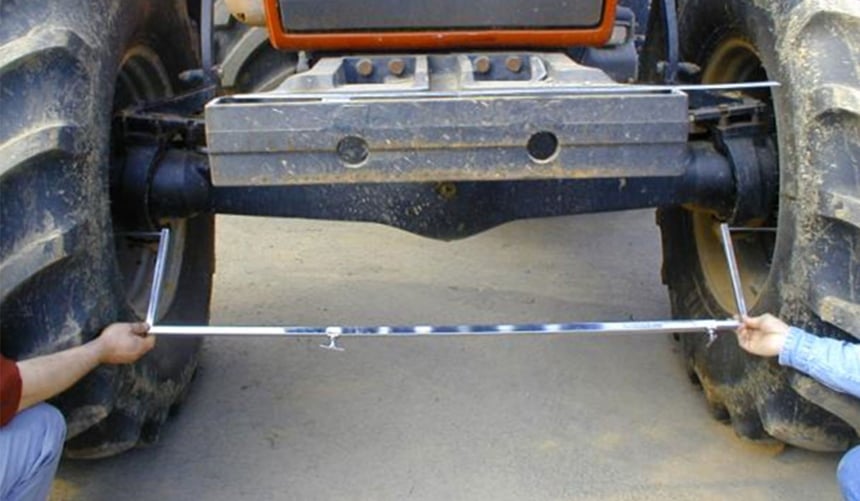 Checking parallelism
Checking parallelism
It is recommended that you check parallelism regularly.
During your day-to-day work, your tractor wheels are effectively placed under considerable strain:
- ruts,
- rugged terrain,
- frequent changes of type of ground,
- excess torque…
All these constraints will slightly modify the settings, but which are repeated frequently and with time will lead to sufficient vibrations to accelerate wear to the rubber in your tread.
Checking the settings frequently will allow you to preserve your equipment and ensure that it lasts several thousand hours longer.
The Bridgestone-agriculture.eu blog is written and administered by tractor tyre experts who are available to provide you with the advice you need on the subject of your agricultural tyres. They allow you to maximise your productivity with information on all subjects linked to tyres: Cheap tractor tyres — Technical data for agricultural tyres — Air pressure advice — Solutions to avoid soil compaction — Sprayer tyre pressure — Why and how to ballast your tractor tyres — When to use dual wheels — The mechanical causes of abnormal wear — Cheap agricultural tyres – etc.
To learn more and boost your farm's profits, Bridgestone-Agriculture is offering you a free, detailed white paper that explains the essential role your agricultural tyres play in your productivity.
Most people who read this article have also read some of the following articles:
- 5 essential techniques to optimise your agricultural tyres
- Which agricultural tyres are most suitable for working on sloping land
- How to maximise traction with my tractor tyres
- Agricultural contracting companies: improve team awareness about tyres
- Equipment sharing cooperatives: How to manage the agricultural tyre budget?
- Duals or low-pressure agricultural tyres: which to choose?
- What is the maximum load that your tractor tyres can carry?
- How do you ensure that your tractor tyres have a good self-cleaning capacity?
- Agricultural tyre evolution, what impact on my farm?
- Agricultural contractors: improving quality of service with an adapted agricultural tyre
This information is intended only to make you aware of the technical and functional aspects of agricultural tires and their use. It does not allow you to make a judgment or a definitive conclusion on a given problem. Only your agricultural tire expert is able to make a technical assessment and take a final decision, case by case.
Leave a
commentary
Your email address will not be published.
Required fields are indicated with *



